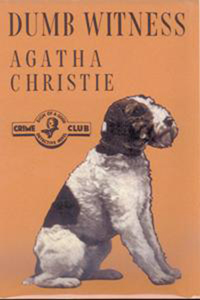“Dumb Witness” (1937, also published as “Poirot Loses a Client”) is a straightforward Agatha Christie mystery in its construction. But it stands out as a Hercule Poirot character piece while also featuring fun additional traits such as a “talking” dog and the hint of the supernatural.
Poirot receives a letter from an elderly potential client, Emily Arundell, who believes someone among her nieces and nephews and their significant others aims to bump her off. But the letter arrives after her death, which has been ruled natural.
First-person narrator Hastings thinks the case is closed, and besides, Poirot can’t help Emily now anyway. Poirot’s sense of justice stands out, as well as his curiosity, which we as readers share. He’s also playfully creative as he invents personas – such as a writer researching a book on Arundell family history – in order to get information out of residents of the close-knit community of Market Basing.

“Dumb Witness” (1937)
Also published as: “Poirot Loses a Client”
Author: Agatha Christie
Genre: Mystery
Series: Hercule Poirot No. 15
Setting: Berkshire, England, 1937
Dog has his day
An especially cute element of “Dumb Witness” is the Arundell household’s terrier, Bob (based on the author’s dog Peter, to whom she dedicates the novel), who enjoys playing catch with a ball from the top of the stairs.
From Hastings’ perspective, Christie writes Bob’s “dialog,” recognizing that humans can often get the gist of what the simple minds of dogs are communicating. (But what is it about talking terriers, specifically? Philip K. Dick features one in “Dr. Bloodmoney” as well.)
Although Bob – who is “accused” in Emily’s stairwell fall for leaving his ball at the top of the stairs – is considered a smart dog, I thought perhaps he would be the “dumb witness” of the title. I thought Poirot would have to somehow get Bob to tell him what he saw.
Instead, the title gets its meaning from a pivotal moment wherein a witness thinks she sees one thing but has in fact seen another.
Character traits as clues
Poirot figures this out through sheer intuition, but I went with it because by this point in the novel Christie has robustly built up the detective’s ability to get a sense of the character of the suspects and witnesses. In that way, it’s similar to “Cards on the Table,” another book where Poirot relies on character traits almost more than clues.
That said, “Dumb Witness” emphasizes the importance of relying on proofs, rather than on someone’s statement. Poirot regularly becomes flabbergasted by Hastings taking people’s verbal claims at face value.
If Hastings were on this case alone, he would easily be steered down whatever path an interviewee wishes. But I can’t blame him, because Christie creates a colorfully shifty lot of people who want Emily’s money. I wouldn’t be surprised if the 2019 film “Knives Out” was particularly influenced by “Dumb Witness,” as it likewise features a loyal servant receiving all the money in a will rather than the bickering relatives.

In Christie’s novel, companion (caretaker) Minnie Lawson is the sole beneficiary in Emily’s will, and she seems genuinely surprised by the windfall and also too dim to even think of plotting a murder. Even Poirot recognizes this, along with the credulous Hastings.
Meanwhile, nephew Charles is a proven thief, niece Theresa is wasteful as she lives the high life, and niece Bella is trapped in a loveless marriage. Plus Bella’s husband and Theresa’s boyfriend, both doctors, have access to poisons.
An unfortunate fable
The author pulls off a neat trick wherein timing is crucial. First there’s the attempted murder (the faux “ball on the stairs” incident), then later Emily dies naturally, but she might’ve been poisoned. In between, Emily’s various wills float around as family members pay “caring” visits and irk her.
Keeping “Dumb Witness” from being a very top-shelf Poirot novel, it’s slow in the middle (when a mulling and unfortunately racist Poirot recounts to Hastings the fable of the “n****r in the woodpile”). Christie tries too hard to create a sense of foreboding as Poirot notes that he is fearful, although he can’t quite pinpoint who he should be afraid of.
On the other hand, the author makes a good point here that detectives probably should be more fearful as they work on a case where the murderer is still on the loose. We know Poirot will be safe as long as Christie’s books sell, but Poirot himself would not know this.
Still, the mystery develops momentum late in the game and will keep you up as long as necessary into the night to find out whodunit. Throw in the unusual elements of Poirot digging into an officially closed case out of respect for the deceased, and a lovably communicative canine, and “Dumb Witness” is certainly interesting among middle-of-the-road Poirots.
Every week, Sleuthing Sunday reviews an Agatha Christie book or adaptation. Click here to visit our Agatha Christie Zone.

